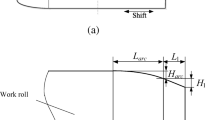Abstract
In cold rolling of silicon steel strip, edge drop directly affects the side cutting and yield of silicon steel. To improve the edge drop of silicon steel in the cold rolling process, a multi-stand coordinated control strategy and model based on multi-objective optimization are proposed. The first step is to analyze the influence of each control stand work roll shifting (WRS) on edge drop through the finite element model (FEM), then determine the edge drop control effectiveness of each work roll shifting actuator. Meanwhile, a fitting model is proposed to solve the limitation caused by the discrete change of efficiency factors in solving the optimal adjustments of each WRS. On this basis, the target model for silicon steel edge drop control is formulated, and the optimal adjustment model of WRS of each stand is established. To realize the optimal coordinated control among the rolling mill stands, a multi-objective optimal model of edge drop control has been established by the overall modeling method. The improved penalty function algorithm is developed to calculate the optimal adjustment of WRS for each stand. The experiments and application show that the proposed multi-objective optimal control strategy and model can effectively improve the accuracy of edge drop control in silicon steel continuous cold rolling.









Similar content being viewed by others
Data availability
All the authors certify that all data were obtained from field experiments.
Code availability
All the authors certify that all the code runs successfully.
References
Jiang ZY, Wei D, Tieu AK (2009) J Mater Process Technol 09:4584
Cao JG, Chai XT, Li YL (2018) Mater Process Technol 252:432
Wang XC, Yang Q, He HN, Sun YZ, Xu D, Liu Y (2020) Int J Adv Manuf Technol 107(1):1–15
Wang QL, Sun J, Li X, Liu YM, Zhang DH (2018) J Manufact Process 34:637
Cao JG, Huang XH, Zhao QF, Xiong HT, Wang T, Zhang ZX (2020) J Central South Univ 51:2772
Wang Q, Sun J, Li X, Liu YM, Wang PF, Zhang DH (2018) J Manuf Process 34:637
Li H, Zhao Z, Zhang J, Kong N, Bao R, Jia S, He F (2018) Int J Adv Manuf Technol 100:2387
Yu H, Liu X, Bi H, Chen L (2009) J Mater Process Technol 209:455
Linghu K, Jiang Z, Li F, Zhao JW, Yu M, Wang YQ (2014) Adv Mater Res 988:257
Yang GH, Cao JG, Zhang J, Song P, Rao KF (2012) J Iron Steel Res Int 19:31
Cao JG, Zhang J, Chen XL, Xu JS, Ouyang JM, Huang T (2003) J Univ Sci Technol 25:32
Portmann NF, Lindhoff D, Sorgel G, Gramckow O (1995) Iron Steel Eng 72:33
Kong FF, He AR, Shao J, Ge XY (2014) J Univ Sci Technol Beijing 36:674
Li D, Liu JC, Tan SB, Yu X (2015) Control Theory Appl 32:970
Noda NA, Hu K, Sano Y, Hosokawa Y (2017) Steel Res Int 88:1600165
Zhang DH, Sun J, Chen SZ, Li X (2019) J Iron Steel Res 31:180
Dong Q, Cao JG, Li HB, Zhou YS, Yan TL, Wang WZ (2015) SteelRes Int 86:129
Moazeni B, Salimi M (2015) Int J Adv Manuf Technol 77:1315
Linghu KZ, Jiang ZY, Zhao JW, Li F, Wei DB, Xu JZ, Zhao XM (2014) Int J Adv Manufact Technol 74:1733
Wang Q, Sun J, Li X, Wang ZH, Wang PF, Zhang DH (2020) Appl Math Model 77:289
Grimble M, Fotakis J (1982) IEEE Trans Autom Control 27:656
Li HJ, Xu JZ, Wang GD, Shi LJ, Xiao Y (2010) J Iron Steel Res Int 17:21
Linghu KZ, Jiang ZY, Zhao JW, Li F, Wei DB, Xu JZ, Zhang XM, Zhao XM (2014) Int J Adv Manuf Technol 74:1733
Funding
This project was supported by National Natural Science Foundation of China (grant no. 52074242, grant no. U20A20187), Natural Science Foundation of Hebei Province (grant no. E2020203068), the Open Project of State Key Laboratory of Rolling and Automation (grant no. 2022RALKFKT001), and Liao Ning Revitalization Talents Program of Liao Ning Province (no. XLYC2007087). Moreover, the authors are very grateful to Dr. Sun Jie from Northeastern University for providing suggestions.
Author information
Authors and Affiliations
Contributions
Pengfei Wang provided a literature review of metal rolling.
Jiannan Li carried out the process of data calculation.
Huagui Huang conducted the design of the experiment.
Shuwei Duan and Dewei Wang conducted experimental operation and data collation.
Corresponding authors
Ethics declarations
Ethics approval
Ethical approval was not involved in this study.
Consent to participate
All the authors agree to participate.
Consent for publication
All the authors agree to publish.
Employment
Pengfei Wang is an associate professor of Yanshan University.
Huagui Huang is a professor of Yanshan University.
Xu Li is a professor of Northeastern University.
Dewei Wang is an engineer of SWKD Thin Plate Technology Co., Ltd.
Shuwei Duan is an engineer of MCC Captial Engineering & Research Incorporation.
Competing interests
Pengfei Wang has received research support from National Natural Science Foundation of China and Natural Science Foundation of Hebei Province and Open Foundation of The State Key Laboratory of Rolling and Automation.
Huagui Huang has received research support from Key Research and Development Project of Hebei Province.
Xu Li has received research support from National Key R&D Program of China and Fundamental Research Funds for the Central Universities.
Non-financial interests
None.
Additional information
Publisher's note
Springer Nature remains neutral with regard to jurisdictional claims in published maps and institutional affiliations.
Rights and permissions
Springer Nature or its licensor (e.g. a society or other partner) holds exclusive rights to this article under a publishing agreement with the author(s) or other rightsholder(s); author self-archiving of the accepted manuscript version of this article is solely governed by the terms of such publishing agreement and applicable law.
About this article
Cite this article
Wang, P., Li, J., Li, X. et al. Multi-objective optimal edge-drop control in tandem cold rolling of silicon steel strip. Int J Adv Manuf Technol 125, 5385–5395 (2023). https://doi.org/10.1007/s00170-023-10937-w
Received:
Accepted:
Published:
Issue Date:
DOI: https://doi.org/10.1007/s00170-023-10937-w




